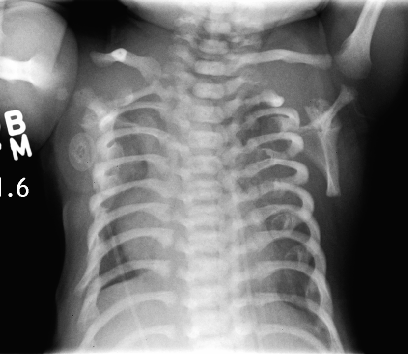Short-Rib Thoracic Dysplasia 4 With Or Without Polydactyly

A number sign (#) is used with this entry because of evidence that short-rib thoracic dysplasia-4 with or without polydactyly (SRTD4) is caused by compound heterozygous mutation in the TTC21B gene (612014) on chromosome 2q24.
DescriptionShort-rib thoracic dysplasia (SRTD) with or without polydactyly refers to a group of autosomal recessive skeletal ciliopathies that are characterized by a constricted thoracic cage, short ribs, shortened tubular bones, and a 'trident' appearance of the acetabular roof. SRTD encompasses Ellis-van Creveld syndrome (EVC) and the disorders previously designated as Jeune syndrome or asphyxiating thoracic dystrophy (ATD), short rib-polydactyly syndrome (SRPS), and Mainzer-Saldino syndrome (MZSDS). Polydactyly is variably present, and there is phenotypic overlap in the various forms of SRTDs, which differ by visceral malformation and metaphyseal appearance. Nonskeletal involvement can include cleft lip/palate as well as anomalies of major organs such as the brain, eye, heart, kidneys, liver, pancreas, intestines, and genitalia. Some forms of SRTD are lethal in the neonatal period due to respiratory insufficiency secondary to a severely restricted thoracic cage, whereas others are compatible with life (summary by Huber and Cormier-Daire, 2012 and Schmidts et al., 2013). There is phenotypic overlap with the cranioectodermal dysplasias (Sensenbrenner syndrome; see CED1, 218330).
For a discussion of genetic heterogeneity of short-rib thoracic dysplasia, see SRTD1 (208500).
Clinical FeaturesMcInerney-Leo et al. (2015) reported 2 unrelated patients with SRTD and mutations in the TTC21B gene. One was an adult from the British Isles (patient SKDP-203.3) diagnosed with Jeune ATD, who exhibited narrow thorax, brachydactyly, short long bones, and scoliosis. This patient also developed end-stage renal disease (ESRD) at age 3 years and underwent renal transplantation at age 7; hepatic cysts were diagnosed in adulthood. The second patient was an 8-year-old child from China (patient SKDP-208.3) who exhibited short stature, narrow thorax, brachydactyly, polydactyly of the left hand and foot, short long bones, and ESRD.
Molecular GeneticsIn a patient with a clinical diagnosis of asphyxiating thoracic dystrophy, Davis et al. (2011) identified compound heterozygosity for 2 mutations in the TTC21B gene: R411X (612014.0004) and L795P (612014.0005). In vitro and in vivo functional expression studies indicated that the R411X allele was null and the L795P allele hypomorphic. No clinical details on the patient were provided.
In a British adult and an 8-year-old Chinese child diagnosed with Jeune ATD, McInerney-Leo et al. (2015) performed whole-exome sequencing and identified biallelic mutations in the TTC21B gene: compound heterozygosity for a splice site mutation (612014.0006) and a missense mutation (L1202P; 612014.0007) in the adult patient, and homozygosity for a 4-bp insertion (612014.0008) in the child. The mutations were not found in internal or public variant databases. Two additional mutations in SRTD-associated genes were detected in heterozygosity in the younger patient, an R560L substitution in the DYNC2H1 gene (603297) and an L328F substitution in the EVC gene (604831); the authors noted the possibity that these variants might modify the SRTD phenotype.